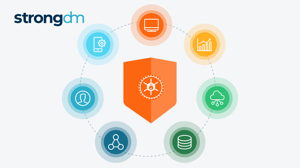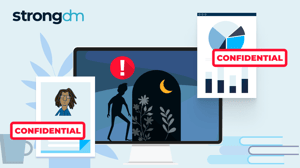User Access Reviews: Best Practices & Process Checklist for 2025

- Role-based, attribute-based, & just-in-time access to infrastructure
- Connect any person or service to any infrastructure, anywhere
- Logging like you've never seen

As teams grow and roles shift, it’s easy for permissions to get out of sync. That’s where user access reviews come in—they ensure every employee, vendor, or service account has exactly the access they need, and nothing more.
Regular reviews reduce risk, prevent privilege creep, and help meet compliance requirements like SOX, ISO 27001, and HIPAA. But manual reviews? They’re slow, messy, and often incomplete.
This guide breaks down the essentials of access reviews—what they are, why they matter, and how to make them painless with real-time visibility, automated workflows, and just-in-time access controls.
What is a User Access Review?
A user access review is the process of systematically evaluating and verifying which systems, applications, and data each user in an organization can access. It ensures that access permissions align with users' current roles and responsibilities, helping reduce security risks, prevent privilege creep, and maintain compliance with regulatory requirements.
Key Components of Access Review Programs
An effective access review program has a few key pieces working together:
- Department managers act as the first line of defense. They regularly check who has access to what, making sure it matches each employee’s current role. This helps prevent unauthorized access to sensitive data.
- A solid review framework keeps track of all user accounts—including both regular users and those with elevated (privileged) access. This makes it easier to spot when someone’s access has gradually increased over time or when vendors or admins have more access than they should.
- Security teams need a clear plan for what to do when they find inappropriate access. That includes steps for removing unneeded permissions and adjusting access levels to follow the principle of least privilege. Doing this helps shrink the attack surface and lowers the risk of insider threats.
💡Make it easy: With StrongDM, simplify your review workflows by centralizing access management, automating permission updates, and ensuring least privilege access across your infrastructure.
Types of User Access Reviews
Organizations use different types of access reviews depending on their security goals and how they operate:
- User-based reviews look at everything an individual has access to across all systems. This gives a full picture of each person’s digital footprint.
- Application-based reviews focus on specific tools or platforms, making sure everyone using them has the right level of access.
- Role-based reviews compare access permissions to standard job roles. This helps prevent privilege creep—when people slowly gain more access than they need—and keeps access aligned with job responsibilities.
- Continuous monitoring adds an extra layer of security by automatically spotting unusual access behavior or risks in real time.
Finally, regular access certifications bring it all together. Managers review and confirm who has access to what, across users and systems. This layered approach helps organizations stay secure while keeping up with changing business needs.
💡Make it easy: StrongDM automates continuous monitoring and provides real-time alerts, helping you proactively identify and manage potential access risks.
Understanding Access Rights and Entitlements
To manage access rights effectively, it’s important to understand the difference between access rights and entitlements:
- Access rights control which systems a user can enter.
- Entitlements define what actions a user can take once inside—like approving transactions or editing sensitive records.
When employees move to new roles or departments, they often keep old access they no longer need. Over time, this leads to privilege creep, creating potential security risks.
That’s why regular access reviews are essential. Managers should check whether each person’s access still fits their current job. As companies add more apps and systems, keeping track of all these permissions gets more complex—and calls for a structured approach.
Especially with granular entitlements (like modifying financial data or customer info), careful oversight is critical. The goal is to give employees the access they need to do their jobs—without exposing the organization to unnecessary risk.
💡Make it easy: StrongDM offers granular access controls, ensuring users have only the precise permissions needed, significantly reducing privilege creep risks.
Why Are User Access Reviews Critical?
Mitigating Security Risks Through Regular Reviews
Regular access reviews serve as a crucial defense against evolving security threats in modern enterprises. When personnel change roles or departments, their accumulated permissions can create significant vulnerabilities through privilege creep.
Companies must implement systematic review processes to identify and revoke unnecessary access rights before they lead to security incidents or reputational damage. These reviews help catch human errors early, such as incorrectly assigned permissions or outdated access levels that could compromise sensitive data.
A well-structured review process examines both standard and privileged user accounts, ensuring that access remains aligned with current job responsibilities. This proactive approach helps organizations maintain compliance with regulatory requirements while protecting critical systems from potential insider threats.
💡Make it easy: StrongDM automates access verification and compliance documentation, enabling proactive security management and effortless compliance.
Benefits of Implementing Access Review Procedures
Well-structured access review procedures transform how organizations handle digital permissions and security governance. Through systematic evaluation of user rights, companies can proactively detect dormant accounts and unnecessary privileges before they create vulnerabilities.
Streamlined operations emerge as departments gain clear visibility into who has access to what resources. This clarity helps managers make informed decisions about resource allocation while maintaining strong security boundaries. Organizations also benefit from smoother onboarding and offboarding processes, as access rights align precisely with role requirements.
Risk reduction occurs naturally when companies maintain granular control over system permissions. By removing excessive access rights and implementing role-based controls, organizations create a more secure environment while supporting operational efficiency.
💡Make it easy: StrongDM’s streamlined processes automate onboarding and offboarding, immediately aligning user access with role requirements.
Common Challenges in Access Management
As digital environments grow, managing user access gets more complex.
- Manual access reviews are slow and error-prone. They frustrate users and increase the risk of security gaps.
- Without automation, it’s hard to keep up with who should have access—especially as roles and responsibilities change.
Modern infrastructure only adds to the challenge. Security teams must:
- Review access across cloud platforms, on-prem systems, and third-party apps
- Ensure everything stays compliant while avoiding rushed, incomplete reviews
It’s even harder with contractors and external partners. These users often need temporary access—but without proper offboarding, their permissions can linger long after they’re gone, opening the door to potential security threats.
💡Make it easy: StrongDM centralizes access management across diverse environments, eliminating manual processes and significantly reducing complexity.
Essential Components of Access Review Policy
Creating an Access Review Policy Template
A strong access review policy template helps your organization stay secure and organized by setting clear rules for managing user permissions.
Here’s what to include:
- Define the scope: List which systems, apps, and data need regular access reviews.
- Set review criteria: Base access decisions on job roles and business needs.
- Include procedures: Explain how to review both regular and privileged accounts, document findings, and make changes.
- Add approval workflows: Make sure reviews follow your org chart and include the right decision-makers.
Make your template flexible, so it works for both routine reviews and special cases—like mergers or department changes.
Also, be sure to track exceptions and temporary access. This keeps things accountable and ensures nothing slips through the cracks.
💡Make it easy: StrongDM provides automated workflows, clear audit trails, and real-time insights, ensuring easy and consistent policy implementation and compliance.
Defining Review Frequency and Schedules
How often you review access matters—and it should depend on the risk level and the type of system:
- High-risk systems and privileged accounts: Review quarterly
- Standard user access: Review annually or every six months, depending on business needs
Create a flexible review schedule that includes:
- Routine reviews on a regular cadence
- Trigger-based reviews for events like:
- Security incidents
- Org changes (e.g., restructuring)
- Major system updates
- Compliance or audit deadlines
To avoid overwhelming your team, spread out the work. You can stagger reviews by department or system to make the process more manageable—while still keeping access under control and secure.
Setting Up Review Responsibilities
Effective access reviews start with clear roles and shared responsibility. Everyone has a part to play:
- Department managers review access for their team members to ensure it matches job roles
- IT admins make updates and keep systems running smoothly
- Security teams oversee the process, making sure reviews follow security policies and compliance rules
- Network admins manage privileged accounts—especially on critical systems that need extra attention
- Compliance officers ensure the process meets regulatory standards and that all changes are well documented
- Resource owners decide who should have access to their systems and work with security teams to set the right access rules
When everyone knows their role, the result is a strong, coordinated approach to secure access control.
Step-by-Step User Access Review Process Checklist
Planning and Preparation Phase
A successful user access review starts with solid prep work. Here’s how to get ready:
- Map out what needs reviewing
- List all applications, databases, and network resources
- Focus first on systems that handle sensitive data
- Document current access
- Record who has access to what, and how permissions are structured
- This gives you a baseline to compare against during the review
- Set clear criteria
- Define what “appropriate access” looks like for each role or function
- Use standardized templates so reviewers can make consistent decisions
- Get stakeholders involved early
- Make sure department heads and system owners know their responsibilities
- Confirm they’re available to help verify access for their teams and systems
With this groundwork in place, your access review will be more focused, efficient, and accurate.
Conducting the Review
When starting your access review, follow these key steps:
- Check each user's access
- Compare current permissions to their job role
- Make sure active accounts match HR records
- Flag any inactive, expired, or unnecessary accounts
- Look at both direct and inherited access
- Review group memberships and how they affect user permissions
- Review privileged accounts carefully
- Check usage patterns and access logs to confirm if elevated access is still needed
- Don’t overlook service accounts and automated processes—they often skip standard controls
- For healthcare environments, ensure access follows the minimum necessary standard for handling health information
- Use an approval workflow
- Have managers validate their team’s access in real time
- This keeps reviews accurate and efficient
- Document any issues
- Note anything unusual or incorrect for follow-up during the remediation phase
Documentation and Reporting
Good documentation is key to successful access reviews—it ensures accountability and creates a reliable audit trail.
Here’s how to do it right:
- Create detailed reports
- Show current access levels, any changes made, and why those changes were approved
- Include info on user roles, permission updates, and any security gaps you found
- Use standardized templates
- Make reviews consistent across departments
- Save time during future assessments
- Capture both automated and manual reviews
- This gives a full view of how access decisions are being made
- Build real-time dashboards
- Track review progress across teams
- Spot areas that need immediate attention
- Monitor completion rates and flag access-related risks quickly
Follow-up Actions and Remediation
Remediation is where access reviews turn into real security improvements.
When you find mismatches between a user’s permissions and what they actually need:
- Take action quickly
- Revoke unnecessary access
- Update permissions to match current roles
- Work together
- Coordinate with system admins, department managers, and resource owners
- Make sure changes don’t disrupt business operations
- Think long-term
- Look for patterns in what’s going wrong (e.g., role definitions, onboarding issues)
- Use these insights to improve processes and prevent the same problems in future reviews
This proactive approach helps you tighten access controls and reduce the workload during future review cycles.
💡Make it easy: StrongDM's unified platform simplifies each phase, from planning to remediation, automating tasks and significantly reducing manual effort.
Best Practices for Access Review Management
Establishing Review Procedures
Establishing structured, automated, and flexible access review procedures—with clear workflows, approval chains, timelines, and standardized responses—ensures consistent, secure, and efficient access management across your organization.
Structured review procedures lay the foundation for consistent access management across your organization. Begin by mapping out clear workflows that detail how different types of access changes should be handled, from routine updates to emergency modifications. These procedures must outline specific approval chains and documentation requirements for each access level.
Your review procedures should incorporate automated notifications to remind reviewers of pending tasks while maintaining accountability throughout the process. Define explicit timelines for each review phase and establish escalation paths when deadlines approach. Consider implementing a staged review approach where critical systems receive priority evaluation.
Create standardized response procedures for common scenarios like role changes or department transfers. This proactive planning helps maintain security while reducing bottlenecks in the review cycle. Remember to build in flexibility for handling exceptions without compromising your security framework.
Implementing Control Lists
Access control lists, especially when combined with role- and attribute-based controls, provide granular, dynamic permission management that requires regular reviews to ensure accuracy, prevent conflicts, and support a strong access governance strategy.
Access control lists establish precise boundaries for user permissions across your digital infrastructure. These granular controls map specific users and groups to allowed resources, creating a detailed framework for permission management.
Role-based access control lists help streamline permissions by grouping similar access needs under defined roles. When combined with attribute-based controls, organizations can refine access rights based on factors like time, location, and device type.
Regular reviews of control lists should examine both individual permissions and group memberships. Focus on identifying obsolete entries, checking for access inheritance conflicts, and verifying that temporary permissions have proper expiration dates. This systematic approach helps maintain clean, effective control lists while supporting your broader access governance strategy.
Managing Privileged Access Reviews
Privileged access requires stringent, well-documented review workflows that regularly assess necessity, scope, and duration of elevated permissions to ensure security, accountability, and minimal risk to critical systems.
Privileged access demands more rigorous review protocols than standard user permissions. Regular evaluations of administrator accounts, service accounts, and emergency access credentials help prevent security breaches while maintaining operational continuity.
Reviews of privileged access should examine both the necessity of elevated permissions and the scope of administrative rights. System owners must verify that privileged users maintain only the essential access levels required for their roles, implementing time-based controls for temporary elevated access.
Create clear workflows for reviewing privileged access modifications, focusing on critical systems that handle sensitive data or control core infrastructure. Document all changes to privileged accounts, including purpose and duration, to maintain a comprehensive audit trail and ensure accountability across your security program.
💡Make it easy: StrongDM’s just-in-time access and automated review capabilities streamline privileged access management, enhancing security and efficiency.
Compliance Requirements and Frameworks
SOX Requirements for Access Reviews
The Sarbanes-Oxley Act mandates regular user access reviews as a fundamental control measure for financial data security. Companies must define clear review cycles for evaluating financial system permissions, documenting each evaluation phase, and maintaining audit trails of access changes.
Successful SOX access reviews require two core components: segregation of duties and comprehensive documentation. Organizations need to validate that no single person can both initiate and approve financial transactions, while maintaining detailed records of who reviews access rights and when these evaluations occur.
Review processes must encompass both automated controls and manual oversight, ensuring that people with access to financial systems maintain appropriate permission levels. Organizations should focus on creating repeatable review workflows that capture access modifications, approvals, and verification steps.
ISO 27001 Access Control Standards
ISO 27001 establishes a framework for managing user access that combines systematic controls with regular monitoring. Organizations implement role-based permissions aligned with business functions while maintaining detailed records of access assignments and modifications.
The standard emphasizes automated access management through clearly defined procedures for granting, modifying, and revoking permissions. This systematic approach helps prevent unauthorized access while streamlining user management across your digital infrastructure.
Review processes must verify that access rights match current job responsibilities and organizational needs. Regular evaluations examine both standard and privileged accounts, ensuring proper authorization levels and removing unnecessary permissions that could create security vulnerabilities.
PCI DSS Compliance Guidelines
Payment card data protection demands rigorous access management protocols under PCI DSS standards. Organizations must implement granular controls that restrict cardholder data access to authorized personnel based on business need-to-know principles.
User access reviews play a central role in maintaining these controls by verifying that each individual's permissions align with their current role and responsibilities. Reviews should examine both standard and privileged accounts accessing payment systems, with particular attention to service accounts and third-party access rights.
The framework emphasizes documenting all access decisions and maintaining clear audit trails of reviews. Organizations need to demonstrate that access rights are regularly evaluated, unnecessary permissions are promptly revoked, and proper segregation of duties exists across payment processing functions.
NIST Access Management Framework
The NIST framework approaches access management through systematic control categories that work together to protect organizational resources. Organizations implement these controls by defining clear access policies, establishing review mechanisms, and maintaining proper documentation of access decisions.
Access management under NIST emphasizes the principle of least privilege while requiring periodic evaluation of user permissions. The framework promotes automation in access review processes, helping organizations maintain consistent oversight of both standard and privileged accounts across their digital infrastructure.
Role-based access control serves as a cornerstone of the NIST framework, allowing organizations to align permissions with job functions and security requirements. Regular reviews verify that access rights match current organizational needs while supporting rapid response to role changes and potential security risks.
💡Make it easy: StrongDM automatically captures comprehensive audit trails and ensures continuous compliance across frameworks like SOX, ISO 27001, PCI DSS, and NIST.
Automating the Access Review Process
Tools for Streamlined Reviews
Modern access review platforms transform manual processes into efficient workflows through intelligent automation capabilities. These solutions centralize user access data across multiple systems and applications, providing a unified interface for reviewing permissions.
Purpose-built review tools offer customizable workflows that adapt to organizational needs while maintaining security standards. They enable reviewers to evaluate access rights through intuitive dashboards, accelerating the decision-making process without compromising thoroughness.
Review automation platforms support delegation workflows, allowing department heads and system owners to manage access reviews within their domains. Built-in reminders and escalation paths ensure timely completion while maintaining clear accountability throughout the review cycle.
Real-time Access Monitoring
Real-time monitoring transforms traditional access controls into dynamic security shields. By continuously evaluating user behavior patterns and access attempts, organizations detect and respond to potential threats before they escalate into security incidents.
Modern monitoring systems flag unusual access patterns, such as off-hours logins or unauthorized privilege escalation attempts. When combined with automated alerts, security teams quickly identify compromised credentials or insider threats targeting sensitive resources.
Role-based monitoring profiles establish baseline access patterns for different user groups, helping distinguish between normal operations and suspicious activities. This proactive approach reduces the window of vulnerability between periodic reviews while strengthening overall access governance.
Audit Trail Management
Comprehensive audit trails capture every access decision and modification across your digital environment. Beyond basic logging, modern audit management incorporates detailed contextual information about who approved changes, why modifications were necessary, and how access patterns evolve over time.
Effective audit trails support both routine reviews and incident investigations by maintaining complete records of access lifecycles. Each trail should document initial permissions, temporary elevations, and eventual revocations while preserving the business justification behind access decisions.
Role-based audit trails organize access data by team function and system type, making it easier to spot unusual patterns during reviews. This structured approach helps reviewers quickly validate appropriate access levels while flagging potential security issues for further investigation.
💡Make it easy: StrongDM provides real-time monitoring, automated workflows, and robust audit trail management, greatly simplifying ongoing access review tasks.
Cloud-Based Access Review Considerations
Managing SaaS Application Access
Modern enterprises face growing complexity in managing access to cloud-based applications. As organizations adopt more Software-as-a-Service solutions, traditional access review methods prove inadequate for maintaining security across distributed systems.
Role-based access control forms the foundation of effective SaaS application management. Organizations must define clear permission levels that align with job functions while supporting seamless workflows. This approach helps prevent excessive privileges while ensuring users maintain necessary access to perform their duties.
Regular evaluation of SaaS access patterns reveals unused accounts and outdated permissions that create unnecessary security risks. By implementing automated provisioning and deprovisioning workflows, organizations maintain clean access logs while reducing administrative overhead. These controls prove particularly valuable when managing contractor access and temporary project teams.
Salesforce Access Review Process
Reviewing Salesforce access permissions requires careful consideration of both standard and custom objects within the platform. System administrators must evaluate profile configurations, permission sets, and role hierarchies to maintain proper security boundaries. Regular assessment of sharing rules and field-level security ensures data remains protected while supporting business operations.
Effective Salesforce access reviews examine user license types and their associated capabilities, particularly when dealing with different editions and feature sets. Platform security demands verification of login IP ranges, session settings, and password policies to prevent unauthorized access through administrative accounts.
User access certification in Salesforce incorporates validation of both internal staff and external partners who may have varying levels of system access. This multi-layered evaluation process helps maintain data integrity while supporting collaboration across organizational boundaries.
Active Directory Integration
Managing access reviews across hybrid environments demands seamless integration with Active Directory infrastructures. Organizations struggle to maintain consistent access policies when users move between on-premises and cloud resources, creating potential security gaps.
Role-based access controls require careful synchronization between Active Directory and cloud identity providers. Proper integration enables automated user provisioning and deprovisioning, reducing manual overhead while strengthening security boundaries. This approach supports unified access governance across the entire technology stack.
Regular validation of directory synchronization ensures accurate user permissions and group memberships. By maintaining clean directory structures and removing stale entries, organizations create a foundation for efficient access reviews that span both traditional and modern infrastructure components.
💡Make it easy: StrongDM integrates seamlessly with SaaS applications, Salesforce, and Active Directory, automating user lifecycle management and ensuring consistent access governance.
Building an Audit-Ready Access Review Program
Creating Process Documentation
Clear documentation serves as the cornerstone of effective access review programs. Your process documentation should outline key workflows, responsibilities, and decision-making criteria to ensure consistent execution across teams.
Well-structured documentation guides reviewers through each phase while maintaining accountability. Map out approval chains, specify required evidence collection methods, and define remediation steps for different scenarios. Include templates for common situations to help streamline the review process.
Document exception handling procedures and create decision trees for complex cases that require escalation. By maintaining detailed process guides, organizations build institutional knowledge that supports both new team members and experienced reviewers in conducting thorough, compliant access evaluations.
Maintaining Review Records
Proper record maintenance transforms access reviews from periodic events into valuable security assets. Organizations need comprehensive archives of review decisions, including approved exceptions and temporary access grants, to demonstrate ongoing compliance efforts.
Review records should capture the full context of access decisions, from initial requests through final determinations. This includes documenting the rationale behind maintaining or revoking permissions, tracking resolution of flagged issues, and maintaining evidence of manager approvals.
Beyond compliance requirements, well-maintained review records provide insights for improving future access governance. By examining historical patterns in access changes and exception requests, security teams can refine their review criteria and strengthen access control policies while reducing unnecessary administrative overhead.
Quarterly Review Implementation
Quarterly access reviews demand careful orchestration to maintain both security and operational efficiency. Begin by mapping out critical systems that require frequent evaluation, such as financial applications and privileged user accounts. Schedule reviews during periods of lower business activity to minimize disruption while maintaining thorough oversight.
Create a standardized workflow that combines automated alerts with manual verification steps. Department managers should receive review notifications three weeks before deadlines, allowing time for thorough evaluation without rushing through critical security decisions.
Establish clear escalation paths for handling review exceptions and delayed responses. When implementing quarterly cycles, phase the rollout by department to prevent overwhelming your security teams while ensuring consistent evaluation quality across all access levels.
💡Make it easy: StrongDM automates documentation and record-keeping, ensuring audit-readiness and simplifying regular review cycles.
Simplifying and Securing User Access Reviews with StrongDM
User access reviews are essential—but managing them manually is complex, time-consuming, and error-prone. StrongDM eliminates that friction by streamlining access governance with automation, real-time visibility, and built-in compliance support.
Here’s how StrongDM makes every phase of your user access review process easier and more secure:
- Automated Access Reviews: Set up scheduled or event-triggered reviews across your infrastructure—on-prem, cloud, or hybrid—and let StrongDM do the heavy lifting.
- Centralized Access Visibility: See who has access to what, across every system, database, and Kubernetes cluster, all in one place.
- Granular Role-Based Controls: Ensure users have only the exact permissions they need—nothing more, nothing less—with precision access down to the command level.
- Real-Time Monitoring: Get alerted the moment access deviates from policy or risk is detected, helping you catch and correct issues before they escalate.
- Effortless Remediation: Revoke or adjust access in just a few clicks with instant policy enforcement—no ticketing systems or spreadsheets required.
- Audit-Ready Reports: Automatically generate detailed review records and logs for SOX, ISO 27001, PCI DSS, NIST, HIPAA, and more.
Make access reviews painless, secure, and compliant. Book a StrongDM demo today to see how easy modern access governance can be.
User Access Reviews: Frequently Asked Questions
What is the user access review approach?
It’s the process of regularly verifying that users have only the access they need, aligned with their current roles, to reduce risk and maintain compliance.
How often should you review user access?
Quarterly for high-risk or privileged accounts; every 6–12 months for standard users, or after role changes and security incidents.
What are the benefits of user access review?
Reduces security risks, prevents privilege creep, supports compliance, and improves operational efficiency.
What are the risks of user access review?
If done manually or inconsistently, it can lead to security gaps, outdated permissions, and non-compliance with regulatory requirements.
About the Author
John Martinez, Technical Evangelist, has had a long 30+ year career in systems engineering and architecture, but has spent the last 13+ years working on the Cloud, and specifically, Cloud Security. He's currently the Technical Evangelist at StrongDM, taking the message of Zero Trust Privileged Access Management (PAM) to the world. As a practitioner, he architected and created cloud automation, DevOps, and security and compliance solutions at Netflix and Adobe. He worked closely with customers at Evident.io, where he was telling the world about how cloud security should be done at conferences, meetups and customer sessions. Before coming to StrongDM, he lead an innovations and solutions team at Palo Alto Networks, working across many of the company's security products.

You May Also Like




